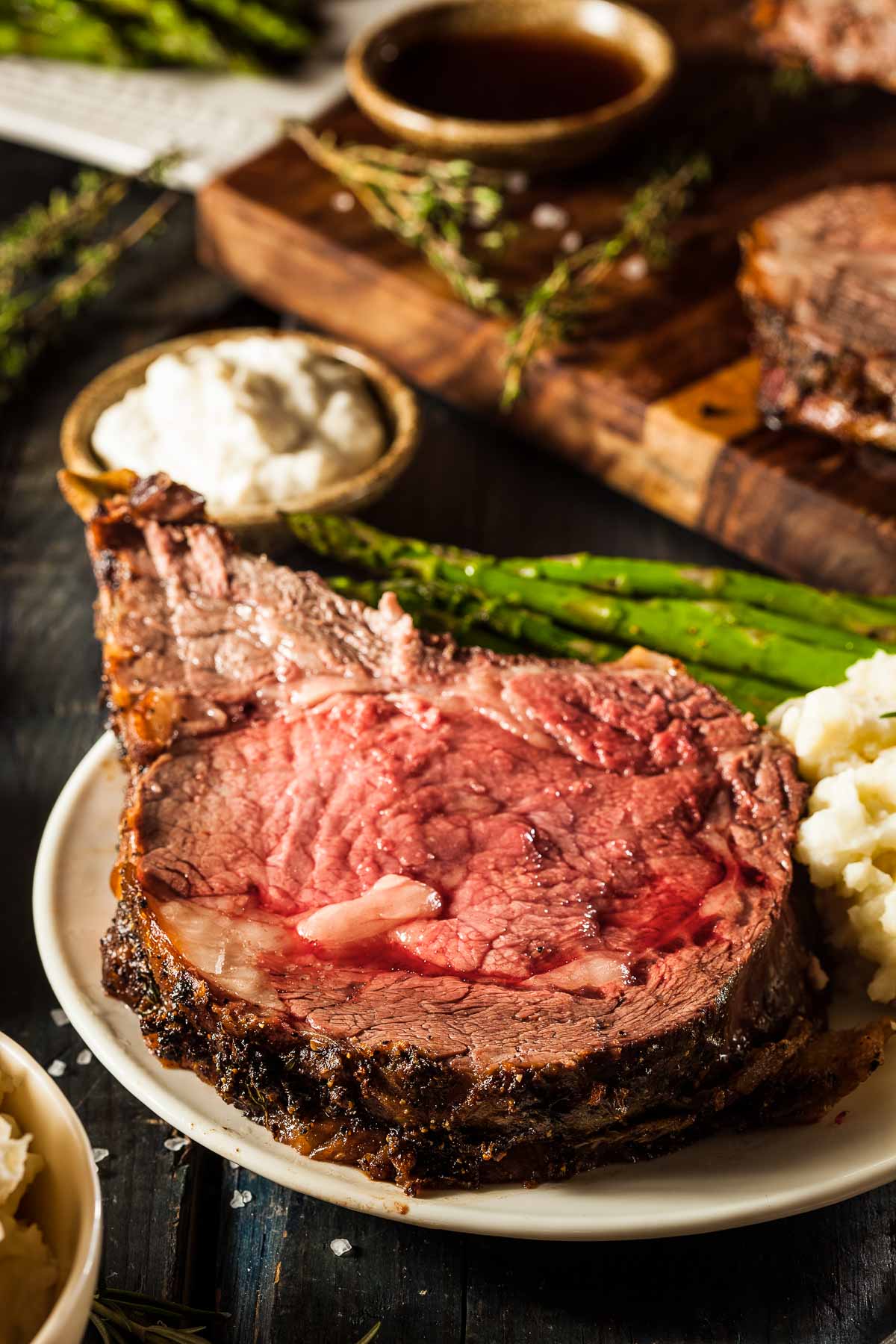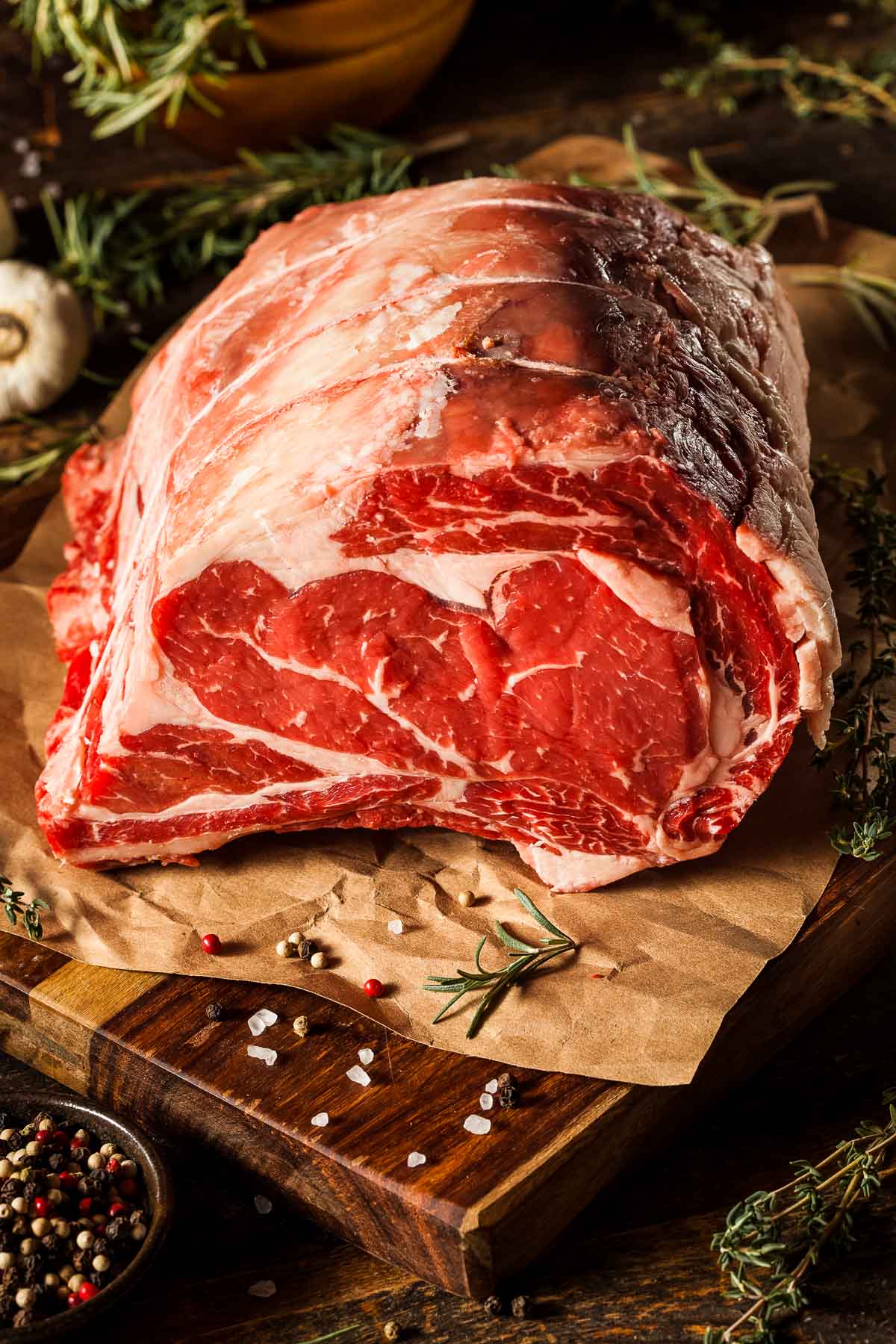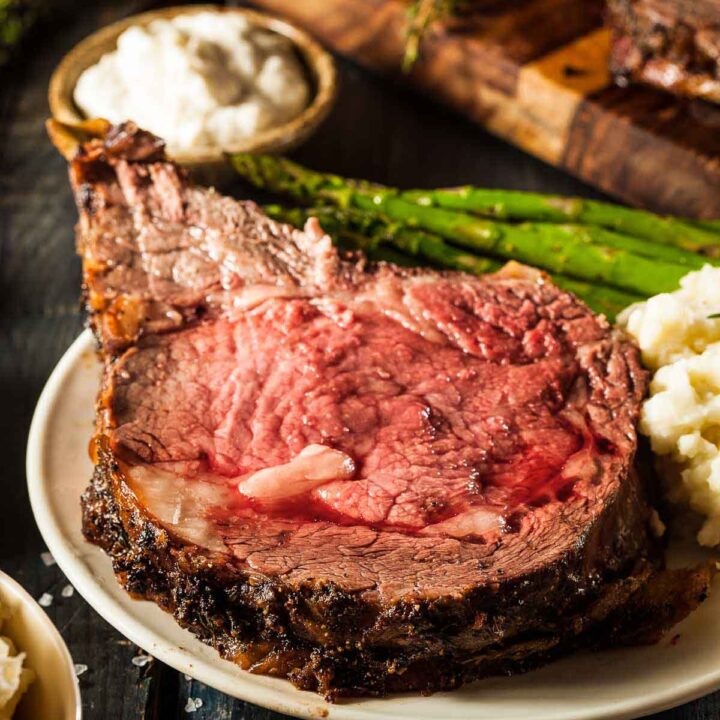This is the foolproof standing rib roast you've been looking for that steals the holiday show. Juicy, tender prime rib with an incredible crust, and it all starts with this wet prime rib rub made with just Dijon mustard, garlic, and cracked peppercorns.
I'll walk you through exactly how to bring the roast to room temperature, tricks to get that gorgeous crust, and how to finish perfectly pink (we even have a downloadable temperature chart just for prime rib). We'll cover bone-in vs. boneless, the exact internal temps to aim for, and the easy, creamy horseradish sauce.

I've made this standing rib roast on every holiday for years. If I find a good deal on a boneless roast, then I'll make this boneless prime rib with a garlic-herb crust, but a prime rib roast is always on the menu. And I always pair it with this easy mushroom risotto with gorgonzola!
Jump to:
Ingredients
For the Roast
- 1 bone-in standing rib roast (prime rib), about 8 pounds (4-7 ribs works; adjust the cook time per the prime rib temperature chart below)
Prime Rib Wet Rub (Dijon-Garlic-Peppercorn Wet Rub)
- ½ cup Dijon mustard
- 1 heaping tablespoon chopped garlic (3-4 cloves; make a paste with the salt)
- 2 tablespoons coarse kosher salt
- 1-2 tablespoons coarsely ground black pepper
Horseradish Cream
- 1 cup sour cream
- ¼ cup prepared horseradish (more or less to taste)
- Kosher salt & freshly ground black pepper, to taste
- 1 spoonful Dijon mustard (optional)

What to Buy
- Bone-in vs. boneless: Bone-in roasts (true "standing" rib roasts) deliver the most flavor and juiciness, plus the bones act as a natural roasting rack. Boneless is easier to carve but tends to cook slightly faster.
- Rib count & weight: Each rib serves about 2 people. A 4-rib roast weighs around 8 lbs and serves 8-10, while a full 7-rib roast can serve up to 14.
- Grade matters: Prime grade has more marbling and tenderness, but choice grade is still excellent if cooked properly.
- Ask your butcher: Request the roast be tied for even cooking and easier carving, and have them French the bones if you want a show-stopping presentation.
Step-by-Step Instructions
- Bring the roast to room temperature: Remove the prime rib from the refrigerator and let it sit out for 1½-2 hours before cooking. This allows for more even roasting and prevents the center from being undercooked while the outside overcooks.
- Preheat the oven: Set your oven to 450°F (232°C).
- Prepare the wet rub: On a cutting board, mash the chopped garlic and salt together with the flat side of your knife to create a paste. In a small bowl, mix the garlic paste with the Dijon mustard and coarsely ground black pepper. Let the mixture sit for 15 minutes to allow the flavors to meld.
- Apply the wet rub: Place the roast on a rack in a roasting pan (ribs down). Slather the mustard mixture over the entire surface of the roast, making sure to coat all sides.
- Initial high-heat sear: Place the roast in the oven and roast for 20-30 minutes at 450°F until the outside has browned.
- Lower the oven temperature: Reduce the oven temperature to 325°F (163°C) without opening the oven door. Continue roasting until the internal temperature reaches 120-125°F for medium-rare. See the temperature chart for prime rib below to make any adjustments. Always use a reliable meat thermometer for accuracy!
- Rest the roast: Remove the roast from the oven and tent it loosely with foil. Let it rest for 20-30 minutes before carving (the temperature will rise by about 5-10°F as it rests).
- Carve & serve: Slice between the bones for large rib portions, or remove the bones and carve thin slices. Serve it with the horseradish cream.
Temperature Chart
Here is a temperature chart for prime rib that you can use to make sure your standing rib roast turns out perfectly every time. You can also download the chart to keep it handy.


Tips for the Perfect Standing Rib Roast
- Choose the right cut: Select a well-marbled prime rib for maximum flavor and tenderness. Both bone-in and boneless work, but bone-in is a true "standing" rib roast.
- Let It come to room temperature: This step is key for even cooking. Take the roast out of the refrigerator 1½-2 hours before roasting.
- Use a meat thermometer: Guessing is risky when cooking an expensive cut like prime rib. Invest in a meat thermometer so you can monitor the roast without opening the oven repeatedly. They're inexpensive and can alert you once the standing rib roast reaches your chosen temperature, making it truly stress-free!
- Don't skip the high-heat sear: That initial blast at 450°F locks in juices and creates a beautifully browned crust.
- Season generously: The wet rub should coat every inch for the best and most consistent flavor. It has plenty of salt already, so unless you use a different rub or skip it entirely, you should be good to go.
- Plan for resting time: Resting allows the juices to redistribute and keeps the meat moist. Tent with foil for at least 20 minutes before carving.
- Carving technique: For large servings, slice between the bones. For thinner slices, remove the bones first, then slice it across the grain.
- Save the drippings: Use the flavorful drippings in the roasting pan to make au jus for serving alongside your horseradish cream. See below for more detailed instructions.
- Adjust for the size & shape of your roast: If your roast is unusually short, long, or thick, adjust the cooking time and start checking temperatures earlier than the chart suggests.
How to Make Au Jus
Au jus ("with juice") is a simple, flavorful sauce made from the roast's drippings. I don't usually make the au jus, opting instead to go with just the horseradish sauce, but here are the instructions if you'd like to make both:
Ingredients
- Pan drippings from your cooked prime rib
- 1-2 cups beef broth (low-sodium)
- ½ cup red wine (optional but adds a lot of flavor)
- Salt & freshly ground black pepper, to taste
Instructions
- Collect the drippings: After removing the roast from the pan, pour the drippings into a heatproof measuring cup. Let them sit for a few minutes so the fat rises to the top. Skim off most of the fat.
- Deglaze the pan: Place your roasting pan over medium heat on the stovetop. Pour in the red wine (if using) or a small amount of the beef broth, scraping up any browned bits from the bottom of the pan.
- Add the broth: Stir in the beef broth and the reserved drippings, then simmer for about 5 minutes or so.
- Strain it for a smooth sauce: Pour the au jus through a fine-mesh strainer into a serving bowl or gravy boat.
- Taste & adjust: Season with salt and pepper as needed. Serve warm alongside the prime rib.
- Note: If you like a slightly thicker au jus, whisk 1 teaspoon cornstarch into 2 tablespoons cold water and stir it in during the simmering step.
How to Use Leftovers
One of the best things about making prime rib is having leftovers - and they're just as luxurious the next day. Here are some delicious ways to use them:
- Reheated and served with sides: We always have loads of leftovers after the holidays, so we usually just reheat our prime rib with leftover risotto, mashed potatoes, etc.
- Prime Rib Sandwiches: Thinly slice leftover prime rib and pile it onto crusty bread or a toasted baguette. Add horseradish cream, caramelized onions, and maybe a slice of provolone or Swiss for the ultimate sandwich.
- French Dip: Serve those sandwiches with a side of warm au jus for dipping.
- Breakfast Hash: Dice leftover beef and toss it with crispy potatoes, onions, and bell peppers. Top with a fried or poached egg.
- Steak and Eggs: Reheat slices of prime rib and serve alongside eggs and buttered toast.
- Prime Rib Tacos: Shred or slice the meat, warm it briefly, and tuck it into tortillas with chimichurri, pico de gallo, or pickled onions.
- Beef & Barley Soup: Use chopped leftovers as the base for a hearty soup!
Reheating Leftovers
The key to reheating prime rib is retaining moisture and avoiding overcooking so it stays tender and juicy. If you have time, bring the meat to room temperature first, and slice only what you plan to eat.
- Oven method (best overall): Wrap slices or the whole roast in foil with a splash of au jus or beef broth. Warm it at 250°F until the internal temperature reaches 165°F.
- Sous Vide (most precise): Seal slices in a bag with au jus or broth and heat in a 165°F water bath for 1 hour.
- Steamer (fastest): Wrap slices in foil with a little broth, then steam for 3-6 minutes until heated through.
- Air Fryer (best for unsliced roast): Wrap it in foil with broth and heat at 225°F, checking every 10 minutes until it's warmed through.
- Microwave: This is usually what we do at our house, even if it's the most unreliable (it's just too easy and most of the time everyone's making a plate at different times). Just make your plate with any sides, and microwave for 1 minutes, adding 15 seconds at a time until it's warmed through.
Frequently Asked Questions
What is a standing rib roast?
A standing rib roast is the same cut of beef as prime rib (it comes from the primal rib section of the cow). It's called "standing" because it's roasted upright on the rib bones.
What's the difference between prime rib and ribeye?
Prime rib is the whole roast, including the rib bones, while ribeye is a steak cut from that roast before cooking.
How much prime rib should I serve per person?
Plan on about ½ pound per person. Keep in mind that you'll likely be serving sides with this, so that amount should be plenty.
What internal temperature should prime rib be cooked to?
For medium-rare (recommended), cook until the internal temperature is 120°F-125°F. The temperature will rise another 5-10°F while it's resting. See our downloadable temperature chart for prime rib for more details.
Can I use a different rub instead of the mustard-garlic one?
A classic salt and pepper rub works really well, especially if you're serving it with both the au jus and horseradish sauce.
How long should I rest the roast before carving?
At least 20 minutes to allow the juices to redistribute.
What's the best way to store leftovers?
Wrap any leftovers tightly in foil or store in an airtight container in the fridge for up to 4 days, or freeze it for up to 3 months.
Related
Looking for other recipes like this? Try these:
Pairings
These are my favorite dishes to serve with a standing rib roast:

Standing Rib Roast with Garlic-Mustard Wet Rub
A standing rib roast is a perfect holiday recipe: it's stress-free, impressive, and most importantly, incredibly delicious!
Ingredients
For the Roast
- 1 Prime Rib Roast, about 8 pounds
- 1 heaping tablespoon chopped garlic
- 2 tablespoons coarse kosher salt
- 1-2 tablespoons coarsely ground black pepper
- ½ cup dijon mustard
For the Horseradish Cream
- 1 cup sour cream
- ¼ cup prepared horseradish
- kosher salt & freshly ground black pepper, to taste
- a spoonful of dijon, optional
For Au Jus
- Pan drippings from your cooked prime rib
- 1–2 cups beef broth (low-sodium)
- ½ cup red wine (optional but adds a lot of flavor)
- Salt & freshly ground black pepper, to taste
Instructions
- Preheat oven to 450°F.
- Bring roast to room temperature (allow to sit on counter for at least an hour).
- Put chopped garlic and salt together onto a cutting board. Using the side of your chef's knife, press down firmly while sliding your knife, making a paste. Mix garlic paste with mustard and pepper. Set aside for at least 15 minutes to allow flavors to meld.
- Place roast on a rack in a roasting pan. Slather roast with mustard mixture, covering all sides. Roast for approximately 20-30 minutes or until the outside is nicely browned.
- Reduce heat to 350°F. Continue cooking roast for approximately 2 hours more or until an internal temperature reaches 120-125°F (this will give you a medium-rare roast which, for prime rib, is recommended). Remove from oven and let rest for 20 minutes. Carve and serve with horseradish cream on the side.
For the Horseradish Cream
- Mix all ingredients together. Allow to sit at room temperature while the roast is cooking. Can also be made in advance and chilled in the refrigerator.
For Au Jus
- After removing the roast from the pan, pour the drippings into a heatproof measuring cup. Let them sit for a few minutes so the fat rises to the top. Skim off most of the fat.
- Place your roasting pan over medium heat on the stovetop. Pour in the red wine (if using) or a small amount of the beef broth, scraping up any browned bits from the bottom of the pan.
- Stir in the beef broth and the reserved drippings, then simmer for about 5 minutes or so.
- Pour the au jus through a fine-mesh strainer into a serving bowl or gravy boat.
- Season with salt and pepper as needed. Serve warm alongside the prime rib.
- Note: If you like a slightly thicker au jus, whisk 1 teaspoon cornstarch into 2 tablespoons cold water and stir it in during the simmering step.
Notes
Rub for rib roast from chow.com.
Nutrition Information:
Yield: 8 Serving Size: 1Amount Per Serving: Calories: 113Total Fat: 9gSaturated Fat: 4gTrans Fat: 0gUnsaturated Fat: 3gCholesterol: 26mgSodium: 2126mgCarbohydrates: 5gFiber: 1gSugar: 2gProtein: 4g
I use Nutritionix to calculate the recipes on this website. This recipe was calculated for 8 servings but seems grossly under in calories. I'm not a nutritionist and prepare this information as a courtesy, so for this particular recipe, I'd encourage you to do further research if the nutritional amounts are important to your health and diet.
- Are Souper Cubes Worth It? (YES!) - November 15, 2025
- Pumpkin Tres Leches Cake (A Make-Ahead Holiday Favorite) - September 29, 2025
- Cucumber and Pineapple Salad with Hot Honey - July 23, 2025








Michelle | A Dish of Daily Life says
I need to try this. My oldest son loves prime rib. My father in law is always the one who made it (my in laws live next door) so I never felt the need to make it myself. He was such a great cook! We lost him to cancer a couple summers ago, and we miss him so much. I've tried to go through and make his old recipes to preserve them for our family, but I haven't come across how he made his prime rib in his notebook. My son would be so surprised if I made this for him. 🙂
Kristy Bernardo says
Oh Michelle, it's such a lovely thought that you might make this to surprise your son. HUGS and Happy Holidays to you!! xoxo
Sharon @ What The Fork Food Blog says
I love making rib roasts but I never make it the same way twice. Can't wait to try this one, it looks AMAZING!
Kristy Bernardo says
Thanks, Sharon!
Dina says
WOW! This looks amazing! I will definitely be adding this to my holiday table. Looks wonderful, Happy Holidays!
Kristy Bernardo says
Thanks so much, Dina! Happy Holidays to you, too!
John@Kitchen Riffs says
I haven't made a standing rib roast in years! And I've had it on the brain recently -- really need to make one again. And I agree you need to pair horseradish with it!
Kristy Bernardo says
YES...Horseradish is key! Thanks, John. I hope you and the Mrs. have a very wonderful holiday!